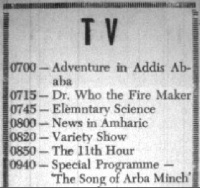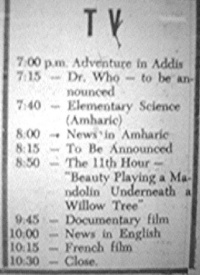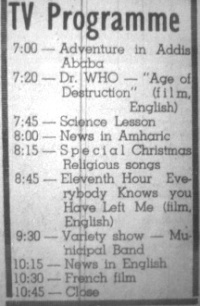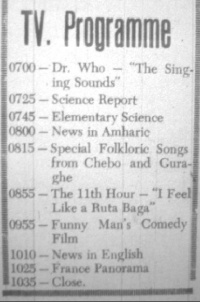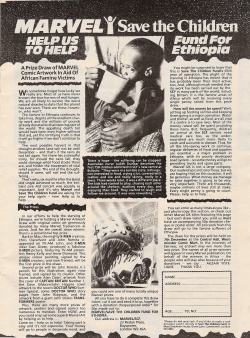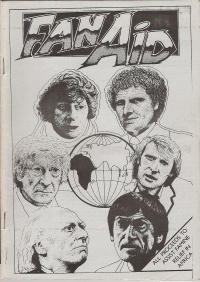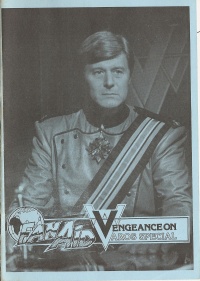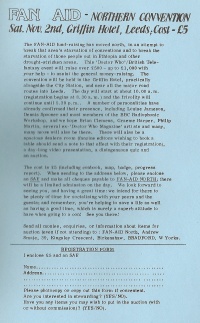Ethiopia
ETHIOPIA is located in Eastern Africa
Profile
| Country Number (33) | 1970 | FIRST WAVE |
| Region | Africa | |
| Television commenced | 2 November 1964 | |
| Colour System | 1979 | PAL |
| Population | 1974 | 25.9 million |
| TV Sets | 1971 | 8,000 |
| Language/s | Amharic, Oromigna, Tigrinya, English | Subtitled? |
Television Stations / Channels
Ethiopia began its television service in 1964.
There is just one television station: Ethiopian Television Service (ETV), a government-owned commercial broadcaster.
Colour transmissions began in 1979 using the PAL colour broadcast system.
Language/s
The main languages of Ethiopia are Amharic, Oromigna, and Tigrinya. English is also recognised as a secondary language. From the evidence given in the TV listings (see below), Doctor Who aired in English (possibly also with subtitles). News bulletins were also provided in French.
DOCTOR WHO IN ETHIOPIA
Ethiopia was the 33rd country to screen Doctor Who (and the 12th of the 13 African nations). Significantly, it was also the very last country to screen Marco Polo, The Reign of Terror and The Crusade, three of the now-missing or incomplete stories (see Selling Doctor Who).
BBC Records
The Seventies records a sale of "(14)" stories by 28 February 1977. The Handbook identifies these as being: C, D, E, F, G, H, J, K, L, M, N, P, Q and R.
In DWM, Ethiopia is identified in the same 14 story Archives.
Although neither source includes, A or B, it is clear that both did screen, making it sixteen stories in total.
Stories bought and broadcast
WILLIAM HARTNELL
Sixteen stories, 77 episodes:
| A | An Unearthly Child | 4 |
| B | The Daleks | 7 |
| C | Inside the Spaceship | 2 |
| D | Marco Polo | 7 |
| E | The Keys of Marinus | 6 |
| F | The Aztecs | 4 |
| G | The Sensorites | 6 |
| H | The Reign of Terror | 6 |
| J | Planet of Giants | 3 |
| K | The Dalek Invasion of Earth | 6 |
| L | The Rescue | 2 |
| M | The Romans | 4 |
| N | The Web Planet | 6 |
| P | The Crusade | 4 |
| Q | The Space Museum | 4 |
| R | The Chase | 6 |
Ethiopia therefore bought GROUP A, B and C of the standard package of William Hartnell stories, bar The Time Meddler.
It was the very last country to air the run of stories from The Romans to The Chase. It is not known why The Time Meddler was omitted. Perhaps there were no longer any available prints in circulation in 1970?
The programme was supplied as 16mm black and white film prints with English soundtracks.
In Alwyn W Turner's 2011 book "The Man Who Invented the Daleks", he notes that "in 1971, [Terry] Nation received £3.12 [in royalties] when The Chase was sold to Ethiopian television".
Origin of the Prints?
Sierra Leone was the previous African country with distribution by Television International Enterprises Ltd (see WRTH); so it’s possible that Ethiopia was sent the same set of prints that had screened in Sierra Leone at the end of 1968.
Transmission
WILLIAM HARTNELL
The series apparently commenced on Thursday, 22 October 1970, and aired weekly on that day, until it switched to Wednesdays just shy of a year later, from 22 September 1971. As noted under TV Listings below, it is not clear when the series ended, or whether any episodes were pre-empted. If the series ran uninterrupted, the 77th and final episode aired on 5 April 1972.
The start time ranged from 7.00pm to 7.35pm. Doctor Who was usually the second programme of the evening.
There is no record that Ethiopia screened Doctor Who again, even after the switch to PAL colour in 1979.
Fate of the Prints?
Being the last ever country to air the English soundtrack prints of the standard GROUP A, B, C, D and E package of William Hartnell stories – including three of the now-missing stories - the Ethiopian Television Service either returned its prints to the BBC in London after April 1972, or had them all destroyed...
TV listings
| ← AIRDATES ...... (CLICK ICON TO GO TO TABLE SHOWING EPISODE BREAKDOWN AND AIRDATES - N/S = story title is Not Stated) |
TV listings have been obtained from the English newspaper The Ethiopian Herald.
Listings give the series name as "Dr Who" or "Dr WHO".
The first direct listing for Doctor Who was on 5 November 1970: "The Fire Maker" (sic). The following week it was "Dr Who – to be announced". The week after that it was "Dead Planet". The next six episodes are clearly identified as being for The Daleks, followed by Inside the Spaceship and Marco Polo. Therefore, the episode labelled "Fire Maker" would actually have been "The Forest of Fear", part three of An Unearthly Child.
"500 Eyes" is the final episode to be identified by its title (4 February 1974). Many of the subsequent newspapers were missing, or didn't have any TV listings. And the few times when there were listings, all they gave was "Dr Who (Film English)", "Dr Who (F.E.)" or close equivalents.
The fact that the programme is identified as being "Film" and "English" does support the thought that the programme was indeed broadcast in that language.
There were no TV listings available between 26 January and 14 June 1972. From 21 June 1972, the 7.00pm timeslot was occupied by "The Abbot and Costello Show". It is not known when that programme began its run. If Doctor Who ran uninterrupted, then its 77th and final episode (The Chase part six) aired on 5 April 1972.
Some of the listings had mistakes: "The Firemaker" as "The Fire Maker"; part one of Inside the Spaceship as "Age of Destruction"; part two of Marco Polo became "The Singing Sounds", and part three "500 Eyes".
FAN AID
In 1985, the FAN AID campaign was launched by Paul Cornell, with the aim of raising money for famine relief in Ethiopia. Cornell organised a convention in Bath on 29 June 1985, managing to raise over £32,000. A second convention was held in Leeds, on Saturday, 2 November 1985. The FAN AID concept was supported by a set of three special fanzines, the proceeds from which went "to assist famine relief in Africa".
DWM supported the campaign, and ran a full-page advertisement in the December 1985 issue (#107). An original piece of comic artwork drawn by Dave Gibbons was offered as a prize draw.
Other magazine coverage of FAN AID:
- DWB #21 (April 1985) had a registration form for the Bath convention.
- DWB #24/25 (July 1985) had a report on the Bath convention.
- DWM #105 (October 1985) had a report on the Bath convention.
- DWM #106 (November 1985) had a registration form for the Leeds convention.
